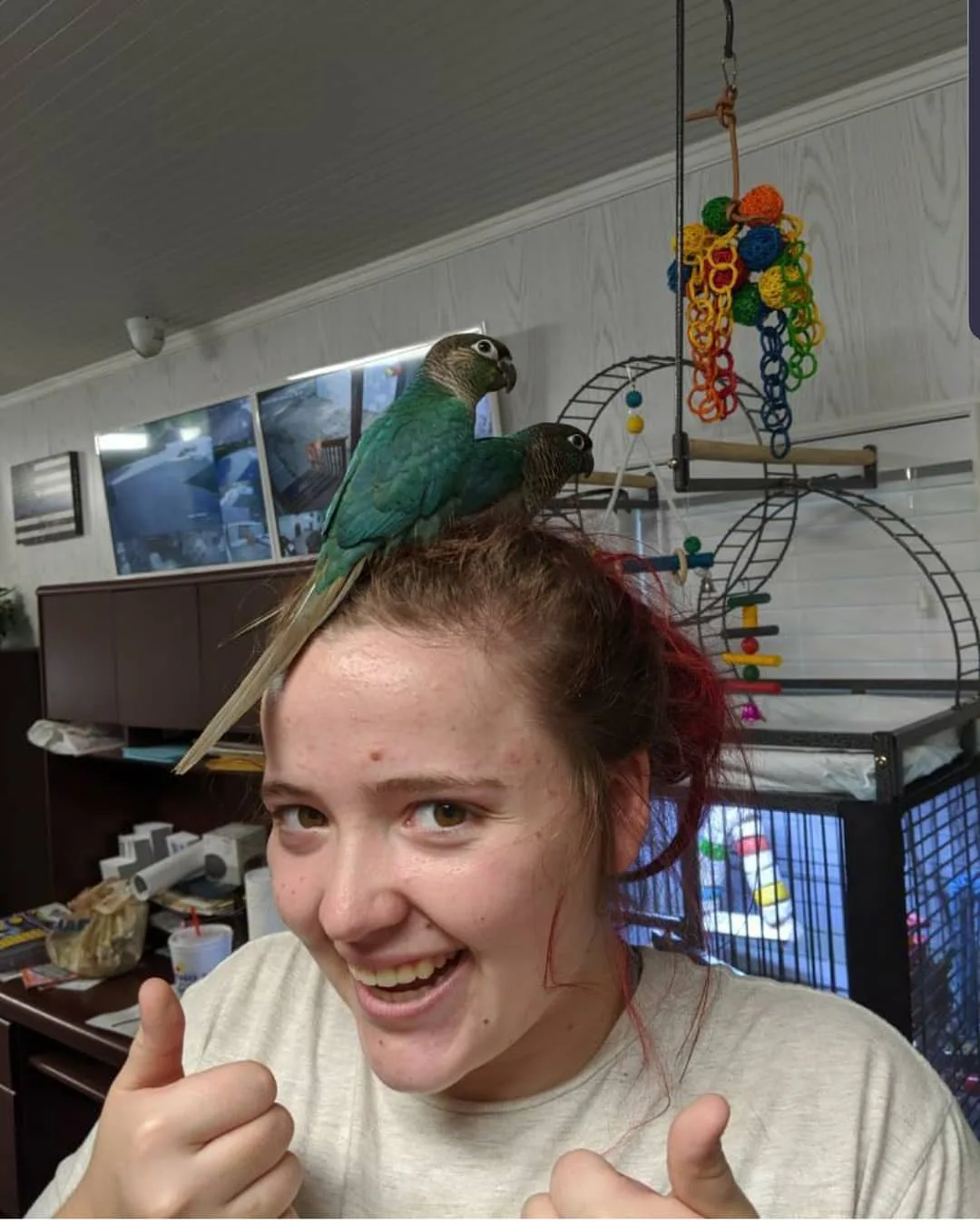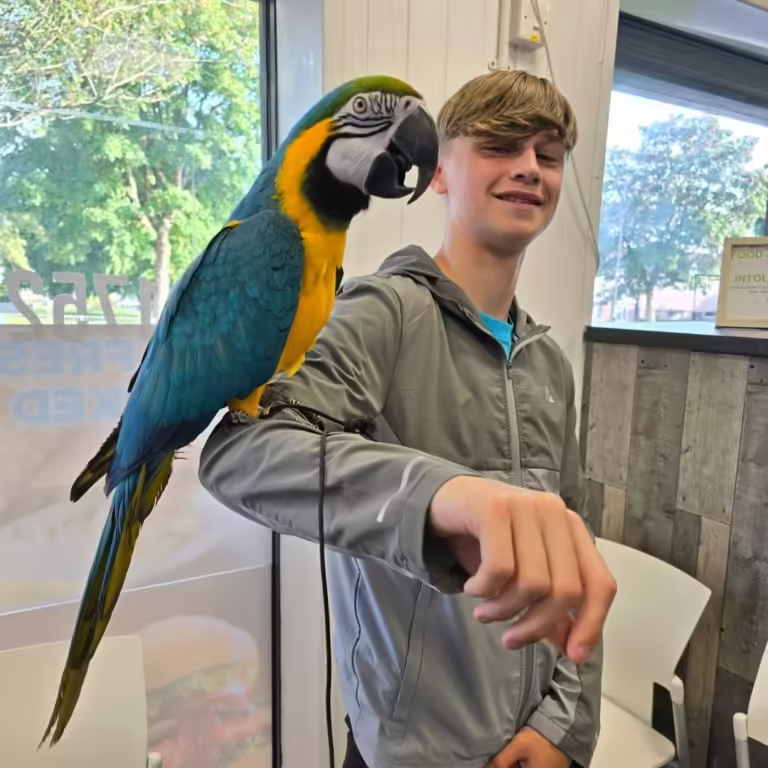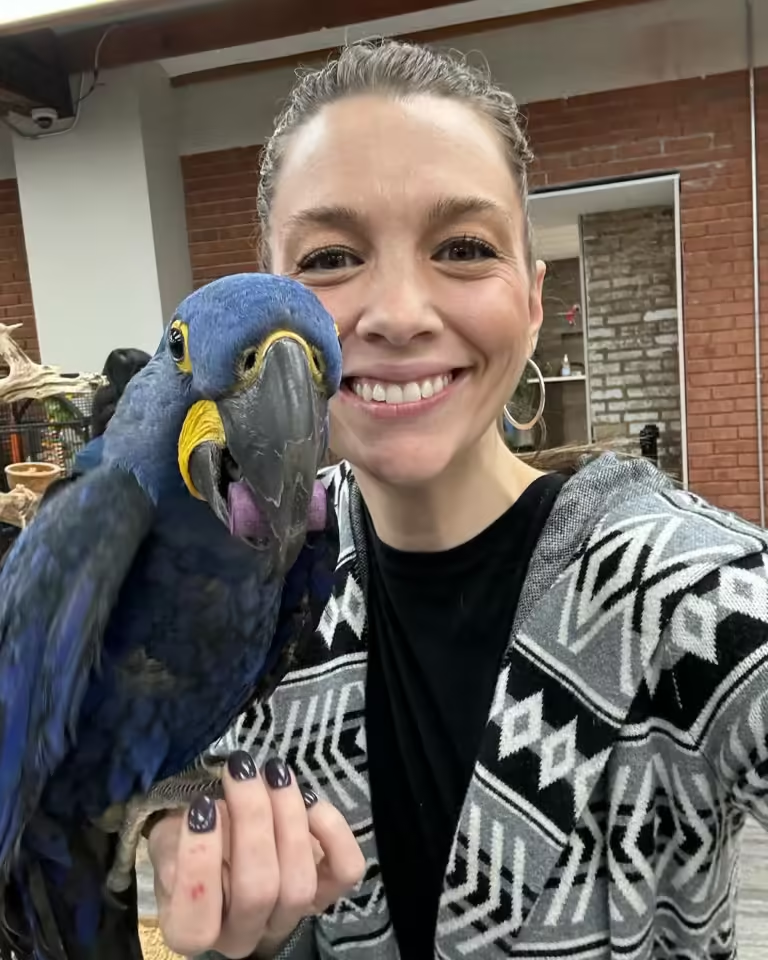- April 23, 2024
Parrot Training Clicker: Master it in 7 Easy Steps!


Is your parrot in need of some training? Our listicle is here to help you unleash the full potential of your feathered friend’s wings, food, fun, and posts. With the power of clicker training, you can establish trust and a strong bond with your parrot, have fun teaching them new tricks and behaviors, and even strengthen their wings a bit.
In this listicle, we’ll walk you through the ins and outs of parrot training using a clicker, cue, wings, and way. From understanding the basics of clicker training to advanced techniques, we’ve got you covered, hands down.
Browse our shop for beautiful birds. Find your perfect parrot companion today
-
Sale Product on sale
 My Name is MINTO & RARA, Male & Female Conure. 20% Off Today – Don’t Miss Out!
My Name is MINTO & RARA, Male & Female Conure. 20% Off Today – Don’t Miss Out!$900.00Original price was: $900.00.$700.00Current price is: $700.00. -
Sale Product on sale


 My Name is MILO, Female Conure. 20% Off Today – Don’t Miss Out!
My Name is MILO, Female Conure. 20% Off Today – Don’t Miss Out!$900.00Original price was: $900.00.$700.00Current price is: $700.00.
Clicker Introduction
The clicker is an essential tool in training parrots. With its simple design and distinct sound, it serves as a clear signal for the bird to understand when they have performed a desired behavior. The click sound acts as a bridge between the moment the parrot does something right and the reward that follows.
One of the key advantages of using a clicker is its consistency. Unlike verbal cues, which can vary in tone or volume, the clicker produces the same sharp sound every time. This consistency helps parrots quickly associate the click with positive reinforcement.
Pairing the click sound with a treat is crucial in clicker training. When the parrot hears the click, they know that they have successfully completed a task and will be rewarded with a treat. This association strengthens their understanding of what behaviors are desired.
Clicker training has been proven effective with parrots of all ages and breeds. It allows trainers to communicate clearly and efficiently with their birds, making the learning process more enjoyable for both parties involved.
Positive Reinforcement
Positive reinforcement is a great training technique for parrots that involves rewarding desired behaviors with treats or praise. This method not only helps to reinforce positive behavior but also strengthens the bond between the trainer and the bird.
By using a clicker as a verbal cue, parrot trainers can mark the exact moment when the bird performs the desired action. The sound of the clicker becomes associated with receiving a reward, which motivates the parrot to repeat the behavior in order to receive more treats.
One of the key benefits of positive reinforcement is that it creates a strong bond between the trainer and the parrot. When a parrot realizes that certain actions lead to rewards, they become more engaged and eager to learn. This makes training sessions more enjoyable and fun for both parties involved.
In addition to strengthening the bond, positive reinforcement also helps parrots understand what is expected of them. By reinforcing behaviors such as stepping onto a hand or spreading their wings, trainers can teach their parrots important cues for daily interactions.
Target Training
Target training is a fundamental aspect of parrot clicker training. It involves using a target stick to guide the bird’s actions and help them learn new behaviors. During a target training session, the trainer presents the target stick, and when the bird touches it with their beak or foot, they are rewarded with treats.
This training technique is highly effective because it allows parrots to focus their attention on a specific object or point. By associating the target stick with positive reinforcement, such as treats, the parrot quickly learns to respond to the cue provided by the stick.
Target training can be broken down into several stages. In the initial stage, the trainer presents the target stick and rewards the parrot for any interaction with it. As the training progresses, more specific behaviors are introduced, such as following or touching the target stick with different body parts.
Clicker Timing
When it comes to clicker training, clicker timing is of utmost importance. The precise timing of the click plays a vital role in reinforcing the correct behavior in parrots.
Immediate clicking is crucial as it helps parrots associate the sound of the click with the desired action or behavior. By clicking at the exact moment the parrot performs the desired behavior, you are effectively communicating to them that they have done something right.
For example, if you want your parrot to learn to step onto your hand, clicking as soon as their foot touches your palm reinforces that specific action. This immediate feedback helps them understand what behavior is being rewarded.
Timing can greatly impact the effectiveness of clicker training. If you click too late or too early, it can confuse your parrot and make it harder for them to understand which behavior is being reinforced. Consistency and precision in timing are key to successful clicker training sessions.
Remember, a click just lasts for a fraction of a second, but its impact can be enormous in shaping your parrot’s behavior. So be sure to practice good timing and make those clicks count!
Consistency is Key
Consistency is the key to successful parrot training using a clicker. When it comes to clicker training, consistency in your approach is crucial for achieving desired results.
Parrots are intelligent creatures that thrive on routine and repetition. By consistently using the clicker as a marker for desired behavior, you are providing clear communication to your bird about what is expected of them. This helps them understand the association between their actions and the reward they receive.
Regular practice sessions are essential to maintain progress in clicker training. Aim for short, frequent sessions throughout the day rather than one long session. This allows your parrot to stay engaged and focused, preventing boredom or frustration.
By being consistent in your training sessions, you create a predictable environment for your parrot. They will quickly learn what behaviors lead to rewards and which ones don’t. This clarity helps them become more confident in their actions, leading to faster and more effective learning.
Remember, consistency is not only about the frequency of training sessions but also about maintaining a consistent approach and set of expectations. Stick to the same cues and rewards each time you train, ensuring that your parrot understands what is expected of them.
Gradual Complexity
In parrot training, gradually increasing the complexity of tasks is key to achieving successful results. By challenging the bird slightly beyond its current abilities, we promote growth and development.
Introducing more complex behaviors in a step-by-step manner allows the parrot to build on its existing skills and expand its repertoire. For example, once a parrot has mastered basic commands like “step up” or “wave,” we can gradually introduce more advanced tricks such as “fetch” or “turn around.”
This incremental approach not only prevents overwhelming the parrot but also keeps the training sessions engaging and stimulating. It allows the bird to feel a sense of accomplishment as it conquers each new challenge.
By gradually increasing the difficulty of tasks, we encourage the parrot’s cognitive abilities and problem-solving skills to flourish. This method ensures that the bird remains motivated and eager to learn, leading to a stronger bond between trainer and parrot.
Remember, patience is key when implementing gradual complexity in parrot training. With time and consistency, your feathered friend will surprise you with its newfound abilities.
Patience and Practice
In the world of parrot training, patience is key. Clicker training requires a consistent and dedicated approach to achieve desired results. Trust between the trainer and the parrot is built over time, as they learn to associate the sound of the clicker with positive reinforcement.
Regular practice sessions are essential for both the parrot and the trainer. These sessions allow the parrot to develop their understanding of the clicker and reinforce learned behaviors. For trainers, it’s an opportunity to fine-tune their timing and technique.
During each training session, it’s important to break down complex tasks into smaller steps. This helps keep the parrot engaged and interested in the training process. By gradually increasing the difficulty level, trainers can ensure that their parrots continue to progress.
A successful case study showcases how a parrot named Charlie went from being hesitant to fully embracing clicker training after several sessions. With lots of patience and practice, Charlie now performs a wide range of tricks on command.
Remember, clicker training is not an overnight process. It requires dedication, consistency, and a genuine interest in your parrot’s development. With time, you’ll witness remarkable progress as your feathered friend masters new skills.
Closing Thoughts
In conclusion, training your parrot with a clicker is an effective and positive way to establish communication and reinforce desired behaviors. Now that you have learned the basics of clicker training for parrots, it’s time to put your knowledge into action. Start by incorporating clicker training into your daily interactions with your parrot. Set small goals and celebrate their achievements along the way.
-
Sale Product on sale

 My Name is DOAL, Female Quaker Bird. 20% Off Today – Don’t Miss Out!
My Name is DOAL, Female Quaker Bird. 20% Off Today – Don’t Miss Out!$900.00Original price was: $900.00.$700.00Current price is: $700.00. -
Sale Product on sale


 My Name is MILO, Female Conure. 20% Off Today – Don’t Miss Out!
My Name is MILO, Female Conure. 20% Off Today – Don’t Miss Out!$900.00Original price was: $900.00.$700.00Current price is: $700.00. -
Sale Product on sale

 My Name is HERCULES, Male Talking Timneh African Grey. 20% Off Today – Don’t Miss Out!
My Name is HERCULES, Male Talking Timneh African Grey. 20% Off Today – Don’t Miss Out!$1,600.00Original price was: $1,600.00.$1,400.00Current price is: $1,400.00.
Frequently Asked Questions
How does clicker training work for parrots?
Clicker training works by associating the sound of a clicker with positive reinforcement, such as treats or praise. The clicker acts as a signal to the parrot that it has performed the desired behavior correctly, making it easier for them to understand and repeat the behavior.
What is target training in parrot clicker training?
Target training involves using a designated object, like a stick or a pointer, as a target for your parrot to touch or follow. By associating the target with positive reinforcement, you can train your parrot to move in specific directions or perform various actions.
Why is timing important in clicker training?
Timing is crucial in clicker training because it allows you to mark the exact moment when your parrot performs the desired behavior. By clicking at the right time and immediately following it with a reward, you reinforce the connection between the behavior and the positive outcome.
Tags
What do you think?
Related Articles

Find Parrots for Sale in Aurora IL: Top 5 Must-Visit Spots
Finding the perfect parrot in Aurora, IL, is an exciting adventure for bird lovers. This city offers various options for finding your ideal feathered friend,

Find Parrots for Sale in Trenton NJ: Top 5 Must-See Spots!
Finding the perfect parrot can be a fun adventure. Trenton, NJ, offers plenty of options for bird lovers. From local breeders to pet shops, there

Find Parrots for Sale in Woodbridge Township NJ: Top 5 Must-See Spots!
Finding the perfect parrot can be a fun adventure. Woodbridge Township, NJ offers plenty of options for bird lovers. From local breeders to pet shops,

